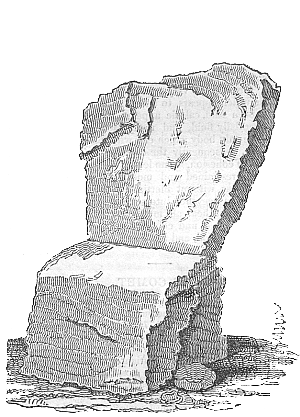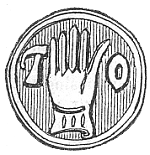Coronation Chair of the O'Neils of Castlereagh
From the Dublin Penny Journal , Volume 1, Number 26, December 22, 1832.

The curious piece of antiquity represented in the prefixed engraving, was for a long period the chair on which the O'Neils, of Castlereagh, were inaugurated, and originally stood on the hill of that name within two miles of Belfast. After the ruin of Con O'Neil, the last chief of Castlereagh, and the downfall of the family, in the reign of James the First, the chair was thrown down and neglected, till about the year 1750, when Stewart Banks, Esq. Sovereign of Belfast, caused it to be removed to that town, and had it built into the wall of the Butter Market, where it was used as a seat until the taking down of the Market-place a few years ago. It was then mixed with the other stones and rubbish, and was about to be broken, when Thomas Fitzmorris took possession of it, and removed it to a little garden in front of his house in Lancaster-street, Belfast, where it remained till the present year, when it was purchased from him for a young gentleman of cultivated mind and elegant tastes, R. C. Walker, Esq. of Granby Row, Dublin, and Rathcarrick, in the County of Sligo, who has had it removed to the latter place, where it will be preserved with the care due to so interesting a monument.
This Chair, which is very rudely constructed, is made of common whin stone--the seat is lower than that of an ordinary chair, and the back higher and narrower.
Respecting its antiquity, we have nothing to offer beyond conjecture. The branch of the O'Neils to whom it appertained, shot off from the parent stem in the 10th century, and is still represented by the present Earl O'Neil; but this inaugural chair may have belonged to the ancient chiefs of the district which they subsequently ruled. Such chairs, or sometimes mere large stones, on which the impression of two feet were sculptured, were placed in some elevated spot in every lordship or territory; and an allusion to them, as well as to the mode of electing the chiefs and tanists, occurs in the poet Spencer's curious "View of the state of Ireland."
Eudox . What is this which you call tanist and tanistry? these be names and terms never heard of nor known to us.
Iren . It is a custome amongst all the Irish, that, presently after the death of one of their chief lords or captains, they doe presently assemble themselves to a place generally appointed and knowne unto them, to choose another in his stead, where they do nominate and elect, for the most part, not the eldest sonne, nor any of the children of the lord deceased, but the next to him in blood, that is the eldest and worthiest, as commonly the next brother unto him, if he have any, or the next cousin, or so forth, as any is elder in that kindred; and next to him do they choose the next of the blood to be tanist, who shall next succeed him in the said captaincy, if he live thereunto.
Eudox . Do they not use any ceremony in this election? for all barbarous nations are commonly great observers of ceremonies and superstite rights?
Iren . They use to place him that shall be their captaine upon a stone, always reserved to that purpose, and placed commonly upon a hill; In some of which I have seen formed and engraven a foot, which they say was the measure of their first captain's foot; whereon hee standing, receives an oath to preserve all the auncient former customs of the countrey inviolable, and to deliver up the succession peaceably to his tanist, and then hath a wand delivered unto him by some whose proper office that is; after which, descending from the stone, he turneth himself round, thrice forwards and thrice backwards.
Eudox . But how is the tanist chosen?
Iren . They say he setteth but one foot upon the stone, and receiveth the like oath that the captaine did.
There was, and probably still is, another stone chair on which the O'Neil's of Tyrone, the chief branch of the family, were inaugurated. It is marked in some of our old maps under the name of--"The stone where they make the O'Neils." And there are similar chairs to be found in other districts.

This curious mode of inauguration is of very remote antiquity in Ireland, and said to have been iritroduced even before the arrival of the Milesians by the Tuatha de Danan colony. Our readers are, no doubt, familiar with the history of the stone coronation chair, now in Westminster Abbey, called "The Fatal Stone," which that ancient people are said to have brought with them into Ireland, and to which such superstitious veneration was paid, not only here but in Scotland. It was supposed that in whatever country this stone was preserved, a prince of the Scythian race should govern, and, in consequence of this belief, was sent to Scotland for the coronation of Fergus the first King of the Scots, and who was of the blood royal of Ireland. Here it remained, and was used by the subsequent monarchs, till in the year 1296 it was conveyed to London by Edward the First, where it has been ever since appropriated to the same purpose.
We shall have frequent opportunities in our future numbers of returning to the history of the illustrious family of the O'Neils, and in the meantime present our readers with an engraving of their arms--the bloody hand--from an impression from the silver signet ring of the celebrated Turlough Lynnoch. It was found a few years ago near Charlemont, in the county of Armagh, and is at present in the possession of a gentleman of that county.
P.
